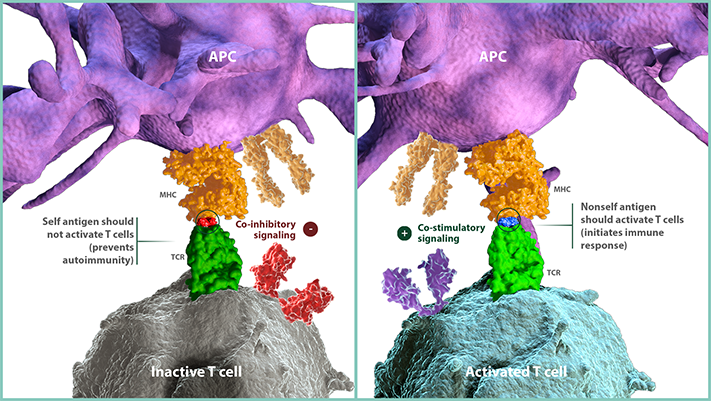Immune Activation: Recognizing Threats
Differentiating self from nonself is a hallmark of the immune response
The immune system is a network of tissues, cells, and signaling molecules that work to protect the body by recognizing and attacking foreign cells, while seeking to minimize the damage to healthy cells.1,2 This ability to differentiate self (the body’s own normal cells) from nonself (abnormal/foreign cells) is a hallmark of the immune response.2,3 The capacity of the immune system to recognize self antigens and accept the presence of normal cells is known as self-tolerance.2 When self-tolerance fails, it can result in autoimmunity, whereby the immune system may fail to discriminate self from nonself and attack normal cells.4


Antigens, small molecules or peptides capable of eliciting an immune response, are a key element in this process of distinguishing self from nonself.1 Classified as either self or nonself, antigens serve as labels that enable the immune system to distinguish between a normal interaction (self) and an encounter with a foreign threat (nonself).1 Inactive T cells search for nonself antigens by transiently binding to antigens presented by major histocompatibility complexes (MHCs) on antigen-presenting cells (APCs).5 Recognition of nonself antigens activates cytotoxic T cells.1 Although they originate from normal cells, tumor antigens can be recognized as nonself. Neoantigens, a type of tumor antigen, arise from normal self proteins that have mutated or been modified, making them unique to the tumor and previously undetected by the immune system.3,6
To prevent autoimmunity, immune cells learn to overlook self antigens both during their maturation (central tolerance) and as they circulate in peripheral tissue (peripheral tolerance).2 Most self-reactive T cells are eliminated early in their development; however, peripheral tolerance exists to prevent recognition of self antigens that may not have been encountered during maturation. Immune checkpoint pathway interactions are one mechanism of peripheral tolerance.2,7


The immune system identifies nonself invaders through both innate and adaptive immunity. The innate immune response is rapid, while the adaptive immune response is not as immediate but can produce a durable response through the development of memory cells, including memory T cells.1,8 Chronic exposure to nonself antigen can promote the accumulation of memory T cells.8 Innate and adaptive immunity are activated through distinct and often complementary mechanisms that deploy different effector cells to attack and destroy abnormal/foreign cells such as cancer.1
References
1. Warrington R, Watson W, Kim HL, Antonetti FR. An introduction to immunology and immunopathology. Allergy Asthma Clin Immunol. 2011;7(suppl 1):S1. 2. Van Parijs L, Abbas AK. Homeostasis and self-tolerance in the immune system: turning lymphocytes off. Science. 1998;280(5361):243-248. 3. Mapara MY, Sykes M. Tolerance and cancer: mechanisms of tumor evasion and strategies for breaking tolerance. J Clin Oncol. 2004;22(6):1136-1151. 4. Sakaguchi S. Naturally arising CD4+ regulatory T cells for immunologic self-tolerance and negative control of immune responses. Annu Rev Immunol. 2004;22:531-562. 5. Murphy K. Janeway’s Immunobiology. 8th ed. Garland Science: New York, NY: 2011:275-386. 6. Schumacher TN, Schreiber RD. Neoantigens in cancer immunotherapy. Science. 2015;348(6230):69-74. 7. Pardoll DM. The blockade of immune checkpoints in cancer immunotherapy. Nat Rev Cancer. 2012;12(4):252-264. 8. Nikolich-Zugich J. Ageing and life-long maintenance of T-cell subsets in the face of latent persistent infections. Nat Rev Immunol. 2008;8(7):512-522.

